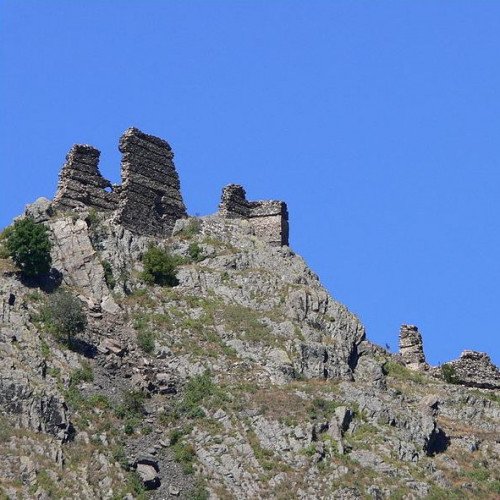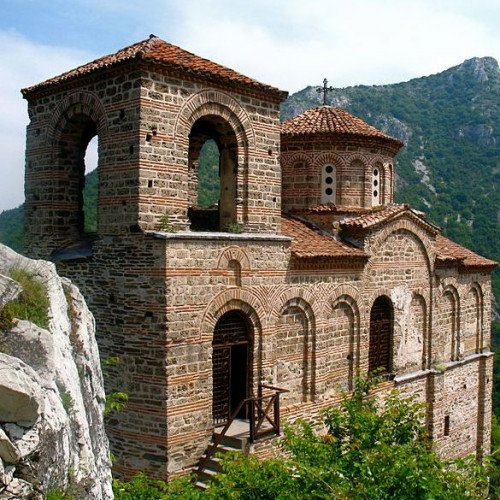Castles of "Bulgaria" ANEVO FORTRESS vs ASEN'S FORTRESS

ANEVO FORTRESS
The Anevo Fortress (Bulgarian: Аневско кале, Anevsko kale) or Kopsis (Копсис) is a medieval castle in central Bulgaria, the ruins of which are located some 3 kilometres (1.9 mi) from the village of Anevo in Sopot Municipality, Plovdiv Province. Constructed in the first half of the 12th century, it lies on a steep hilltop at the southern foot of the Balkan Mountains, not far from the Stryama river. In the end of the 13th century, the fortress was the capital of a small short-lived quasi-independent domain ruled by the brothers of Tsar Smilets of Bulgaria, Voysil and Radoslav. The hill where the Anevo Fortress is situated has been populated since no later than Antiquity (3rd–1st century BC), with habitation also evident throughout the Ancient Roman (1st–4th century), early Byzantine (5th–6th century) and Bulgarian (11th–14th century) periods of rule. The castle reached its heyday in the last quarter of the 13th century, when under the rule of the Bulgarian nobles (bolyari) Voysil and Radoslav it was the capital of a quasi-independent realm. The domain comprised the landholdings of the two renegade brothers of Tsar Smilets, which lay between the Balkan Mountains and Sredna Gora, approximately from modern Sliven west to Kopsis. The Anevo Fortress is dominated by its fortified inner city or citadel, surrounded by defensive walls with gates and towers. The entire fortress was around 7,000–8,000 square metres (75,000–86,000 sq ft) in area, of which 5,000 m2 (54,000 sq ft) are taken up by the citadel and other archaeological remains, the unfortified part of the city measured around 1,000 m2 (11,000 sq ft) and a monastery with adjacent buildings amounted to 1,000–1,500 m2 (11,000–16,000 sq ft). In total, the Anevo Fortress is thought to have had eight defensive towers, of which only several have been preserved. The towers are either rectangular or polygonal in shape, and their ruins reach up to 12 metres (39 feet) in height.
Statistics for this Xoptio

ASEN'S FORTRESS
Asen's Fortress (Bulgarian: Асенова крепост, Asenova krepost), identified by some researchers as Petrich (Петрич), is a medieval fortress in the Bulgarian Rhodope Mountains, 2 to 3 kilometres (1.2 to 1.9 mi) south of the town of Asenovgrad, on a high rocky ridge on the left bank of the Asenitsa River. Asen's Fortress is 279 metres (915 ft) above sea level. The earliest archaeological findings date from the time of the Thracians, the area of the fortress being also inhabited during the Ancient Roman and Early Byzantine period. The fortress gained importance in the Middle Ages, first mentioned in the statute of the Bachkovo Monastery as Petrich in the 11th century. The fortress was conquered by the armies of the Third Crusade. It was considerably renovated in the 13th century (more precisely 1231) during the rule of Bulgarian tsar Ivan Asen II to serve as a border fortification against Latin raids, as evidenced by an eight-line wall inscription. The foundations of fortified walls—the outer ones being 2.9 metres (9.5 ft) thick and preserved up to a height of 3 metres (10 ft), originally 9 to 12 metres (30 to 39 ft) high—a feudal castle, 30 rooms and 3 water repositories have been excavated from this period. The best preserved and most notable feature of Asen's Fortress is the Church of the Holy Mother of God from the 12th-13th century. It is a two-storey cross-domed single-naved building with a wide narthex and a large rectangular tower, and features mural paintings from the 14th century. The conservation and partial restoration works on the church were finished in 1991 (the whole fortress was left to decay after the Ottoman conquest in the 14th century and only the church remained standing in its original appearance as it was used by the local Christians) and now it is in regular use as a Bulgarian Orthodox church. Taken by the Byzantines after Ivan Asen II's death, the fortress was once again in Bulgarian hands at the time of Ivan Alexander in 1344 only to be conquered and destroyed by the Ottomans during their rule of Bulgaria. The town of Asenovgrad takes its modern name from the fortress, formerly being named Stanimaka.